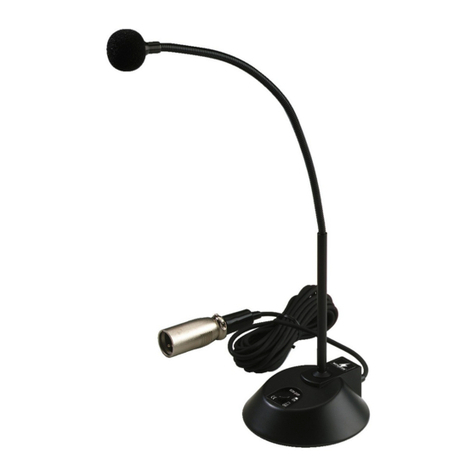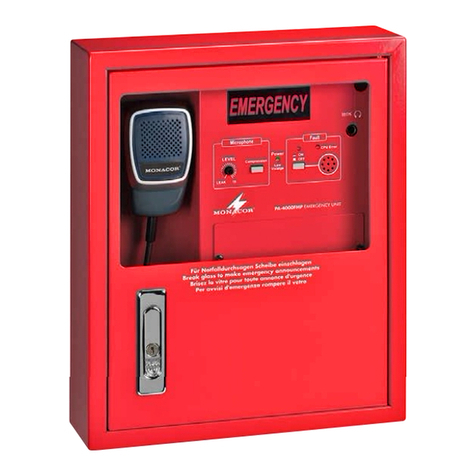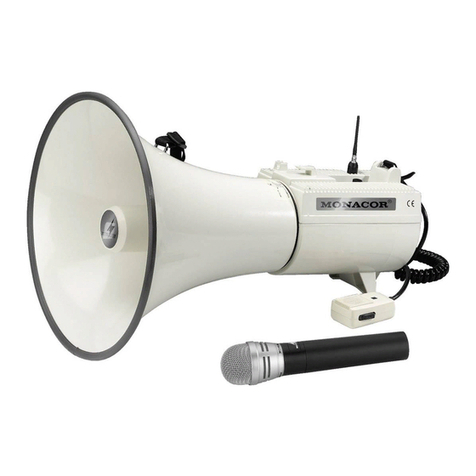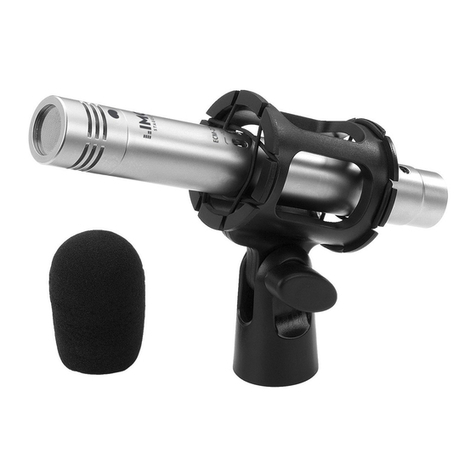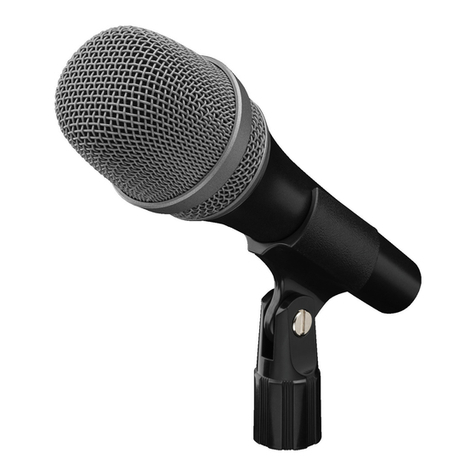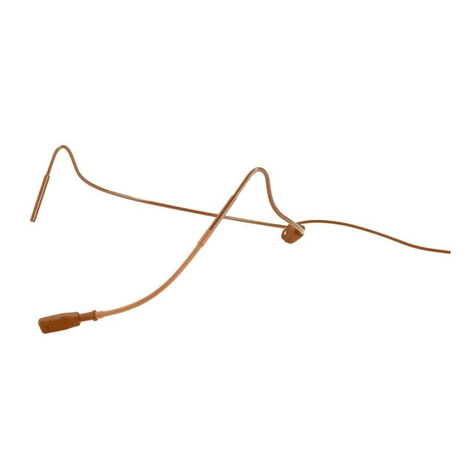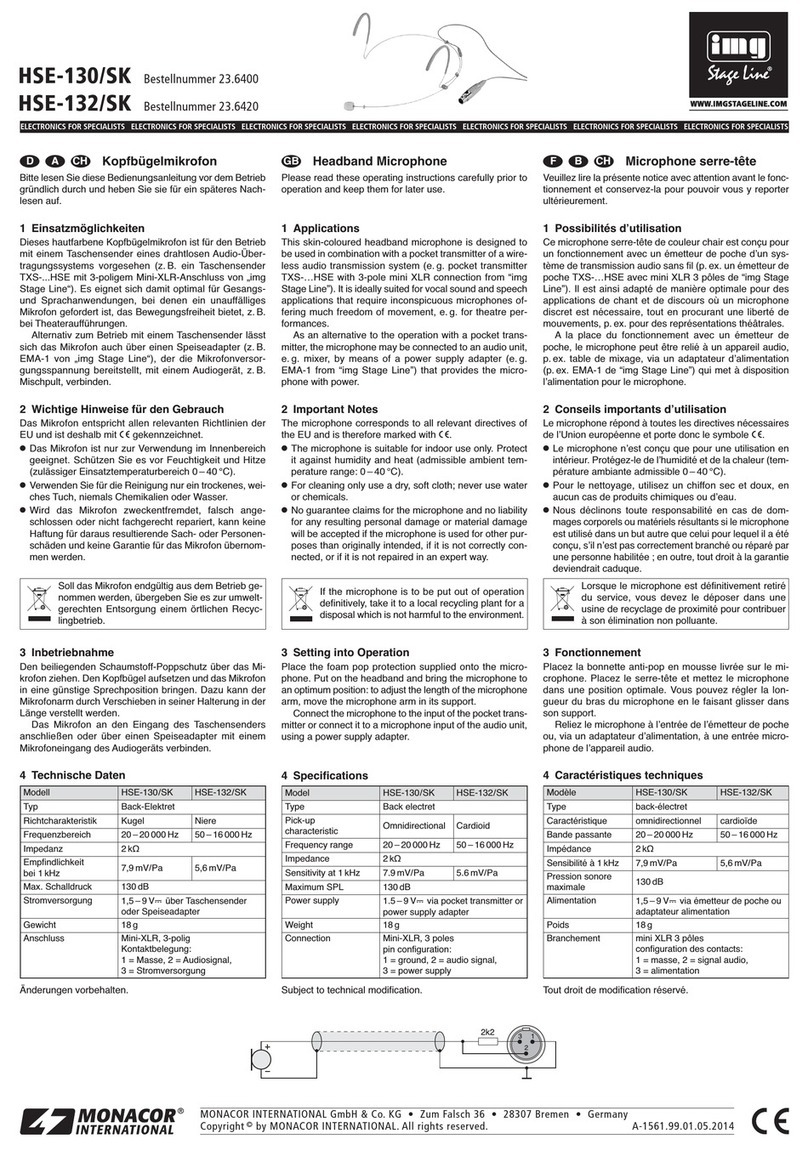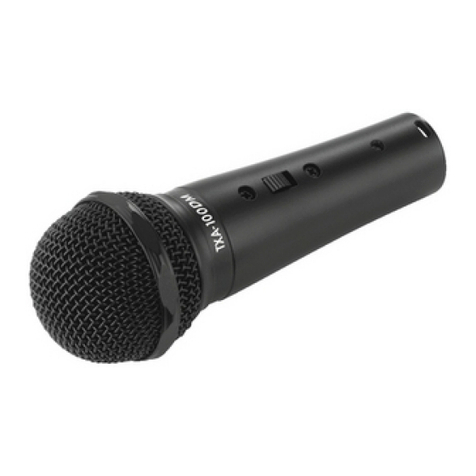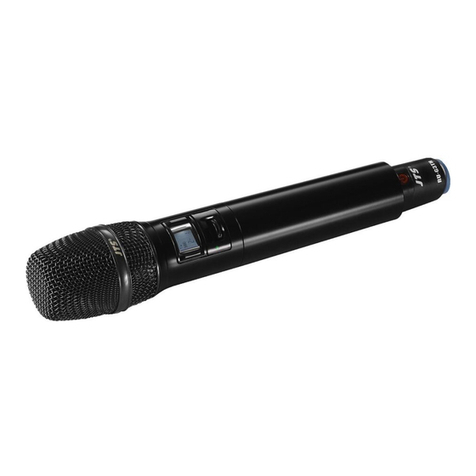Kopfbügelmikrofon
Bitte lesen Sie diese Bedienungsanleitung vor dem
Betrieb gründlich durch und heben Sie sie für ein
späteres Nachlesen auf.
1 Einsatzmöglichkeiten
Das Elektret-Kopfbügelmikrofon HSE-86 eignet sich
optimal für Gesangs- und Sprachanwendungen, die
viel Bewegungsfreiheit erfordern, z. B. im Telefon-
dienst, auf der Bühne, beim Sport. Es lässt sich an
ein Audiogerät mit einer 3,5-mm-Klinkenbuchse für
Elektret-Mikrofone anschließen, z. B. an die fol-
gende Taschensender von „img Stage Line“:
TXS-820LT, TXS-822LT
TXS-820SX, TXS-822SX
Außerdem kann das Mikrofon auch an den Mikro-
foneingang eines PCs angeschlossen werden.
2 Wichtige Hinweise für den Gebrauch
Das Mikrofon entspricht allen erforderlichen Richtli-
nien der EU und ist deshalb mit gekennzeichnet.
GSetzen Sie das Mikrofon nur im Innenbereich ein.
HSE-86
Best.-Nr. 23.5860
wwwwww..iimmggssttaaggeelliinnee..ccoomm
Schützen Sie es vor Feuchtigkeit und Hitze (zu-
lässiger Einsatztemperaturbereich 0 – 40 °C).
GVerwenden Sie für die Reinigung nur ein trocke-
nes, weiches Tuch, niemals Chemikalien oder
Wasser.
GWird das Mikrofon zweckentfremdet, falsch ange-
schlossen oder nicht fachgerecht repariert, kann
keine Haftung für daraus resultierende Sach- oder
Personenschäden und keine Garantie für das Mi-
krofon übernommen werden.
3 Inbetriebnahme
1) Den mitgelieferten Poppschutz auf das Mikrofon
setzen. Er verhindert bei Sprach- oder Gesangs-
anwendungen nicht nur die Überbetonung von
Explosivlauten (z. B. „b“, „p“, „t“), sondern schützt
das Mikrofon auch vor der Feuchtigkeit des Atems.
2) Den Mikrofonhalter in den Haken des Metallbü-
gels schieben und die beiden Kabelführungen so
Soll das Mikrofon endgültig aus dem
Betrieb genommen werden, übergeben
Sie es zur umweltgerechten Entsorgung
einem örtlichen Recyclingbetrieb.
am Bügel verschieben, dass das Mikrofonkabel
optimal am Bügel entlang geführt wird.
3) Den Bügel aufsetzen und das Mikrofon in eine
günstige Sprechposition bringen.
4 Technische Daten
Typ: . . . . . . . . . . . . . . . . . . . Elektret-Mikrofon
Richtcharakteristik: . . . . . . . Niere
Frequenzbereich: . . . . . . . . 100 – 12 000 Hz
Impedanz: . . . . . . . . . . . . . . 2,2 kΩ
Empfindlichkeit: . . . . . . . . . . 4,5 mV/Pa bei 1 kHz
Maximaler Schalldruck: . . . . 110 dB
Signal-Rausch-Abstand: . . . > 55 dB
Versorgungsspannung: . . . . 2 – 10 V über das angeschlos-
sene Audiogerät
Gewicht: . . . . . . . . . . . . . . . 40 g
Anschluss: . . . . . . . . . . . . . 0,8-m-Kabel mit 2-poligem
3,5-mm-Klinkenstecker,
einschraubbar durch 7,75-mm-
Außengewinde
Änderungen vorbehalten.
Headband Microphone
Please read these operating instructions carefully
prior to operating the microphone and keep them for
later reference.
1 Applications
The electret headband microphone HSE-86 is ide-
ally suited for vocal sound and speech applications
which require much freedom of movement, e. g. for
telephone services, on stage, for sports activities. It
can be connected to an audio unit with a 3.5 mm
jack for electret microphones, e. g. to the following
pocket transmitters from “img Stage Line”:
TXS-820LT, TXS-822LT
TXS-820SX, TXS-822SX
In addition, the microphone may also be connected
to the microphone input of a PC.
2 Important Notes
The microphone corresponds to all required direc-
tives of the EU and is therefore marked with .
GThe microphone is suitable for indoor use only.
Protect it against humidity and heat (admissible
ambient temperature range 0 – 40 °C).
GFor cleaning only use a dry, soft cloth, never use
chemicals or water.
GNo guarantee claims for the microphone or liabil-
ity for any resulting personal damage or material
damage will be accepted if the microphone is
used for other purposes than originally intended,
if it is not correctly connected, or not repaired in
an expert way.
3 Setting into Operation
1) Place the anti-pop protection supplied onto the mi-
crophone. It does not only prevent the overem-
phasis of plosives (e. g. “b”, “p”, “t”) for vocal
sound and speech applications but also protects
the microphone against the humidity of the breath.
2) Slide the microphone support into the hook of the
metal bracket and displace the two cable guid-
If the microphone is to be put out of oper-
ation definitively, take it to a local recycling
plant for a disposal which is not harmful to
the environment.
ances at the bracket so that the microphone
cable is guided along the bracket in an optimum
way.
3) Put on the bracket and place the microphone into
a favourable talk position.
4 Specifications
Type: . . . . . . . . . . . . . . . . . . electret microphone
Directivity: . . . . . . . . . . . . . . cardioid
Frequency range: . . . . . . . . 100 – 12 000 Hz
Impedance: . . . . . . . . . . . . . 2.2 kΩ
Sensitivity: . . . . . . . . . . . . . . 4.5 mV/Pa at 1 kHz
SPL max.: . . . . . . . . . . . . . . 110 dB
S/N ratio: . . . . . . . . . . . . . . > 55 dB
Power supply: . . . . . . . . . . . 2 – 10 V
via the connected audio unit
Weight: . . . . . . . . . . . . . . . . 40 g
Connection: . . . . . . . . . . . . . 0.8 m cable with 2-pole 3.5 mm
plug which can be screwed in
via 7.75 mm outside thread
Subject to technical modification.
Microphone serre-tête
Veuillez lire la présente notice avec attention avant
le fonctionnement et conservez-la pour pouvoir vous
y reporter ultérieurement.
1 Possibilités dʼutilisation
Le microphone serre-tête électret HSE-86 est bien
adapté pour les applications de chants et discours
nécessitant une grande liberté de mouvements, par
exemple service de téléphone, sur scène, lors dʼac-
tivités sportives. Il peut se brancher sur un appareil
audio avec une fiche jack 3,5 femelle pour micro-
phones électret, par exemple aux émetteurs de
poche de la série “img Stage Line” suivants :
TXS-820LT, TXS-822LT
TXS-820SX, TXS-822SX
De plus le microphone peut être relié à lʼentrée
micro dʼun PC.
2 Conseils importants dʼutilisation
Le microphone répond à toutes les directives né-
cessaires de lʼUnion européenne et porte donc le
symbole .
GLe microphone nʼest conçu que pour une utilisa-
tion en intérieur. Protégez-le de lʻhumidité et de la
chaleur (plage de température de fonctionnement
autorisée : 0 – 40 °C).
GPour le nettoyer, utilisez uniquement un chiffon
sec et doux, en aucun cas de produits chimiques
ou dʼeau.
G
Nous déclinons toute responsabilité en cas de dom-
mages matériels ou corporels résultants si le mi-
crophone est utilisé dans un but autre que celui
pour lequel il a été conçu, sʼil nʼest pas correctement
branché ou sʼil nʼest pas réparé par une personne
habilitée ; en outre, la garantie deviendrait caduque.
3 Fonctionnement
1) Placez la bonnette anti-vent/anti-pop livrée sur le
microphone. Elle évite les emphases dʼocclusives
(par exemple “b”, “p”, “t”) pour des applications
de chant ou de discours et protège le micro de
lʼhumidité de la respiration.
Lorsque le microphone est définitivement
retiré du service, vous devez le déposer
dans une usine de recyclage adaptée pour
contribuer à son élimination non polluante.
2) Poussez le support micro dans le crochet de
lʼétrier métallique, poussez les deux guide-câbles
sur lʼétrier de telle sorte que le cordon micro soit
guidé le long de lʼétrier.
3) Positionnez lʼétirer, placez le micro dans la posi-
tion de parole adéquate.
4 Caractéristiques techniques
Type micro : . . . . . . . . . . . . électret
Caractéristique : . . . . . . . . . cardioïde
Bande passante : . . . . . . . . 100 – 12 000 Hz
Impédance . . . . . . . . . . . . . 2,2 kΩ
Sensibilité : . . . . . . . . . . . . . 4,5 mV/Pa à 1 kHz
Pression sonore max. : . . . . 110 dB
Rapport signal/bruit : . . . . . > 55 dB
Alimentation : . . . . . . . . . . . 2 – 10 V
via l’appareil audio relié
Poids : . . . . . . . . . . . . . . . . . 40 g
Connexion : . . . . . . . . . . . . . cordon 0,8 m avec fiche jack 3,5
2 pôles, vissable via un filetage
extérieur 7,75 mm
Tout droit de modification réservé.
®
MONACOR INTERNATIONAL GmbH & Co. KG
•
Zum Falsch 36
•
28307 Bremen
•
Germany
Copyright
©
by MONACOR INTERNATIONAL. All rights reserved. A-1034.99.02.01.2013
D A CH
GB
F B CH
